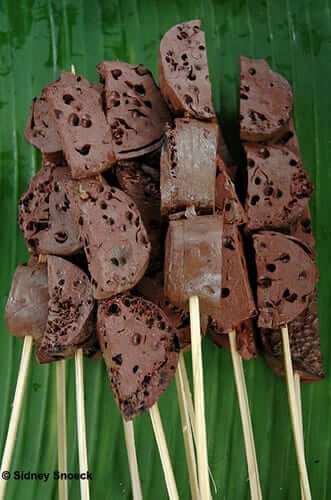10 Popular Street Snacks Still New to Most Travelers
Let’s be honest—taste is weird. What’s delicious to one person can be absolutely horrifying to another. Think about that one food you secretly crave that your friends can’t stand—maybe it’s anchovy pizza, maybe it’s black licorice. Whatever it is, we all have at least one. And that’s the beautiful chaos of flavor: everyone’s palate is a little bit unpredictable.
Now imagine taking that idea global. While you might grab a hot dog or taco on the go, in other corners of the world, street food looks very different—and often much more surprising. From fermented fish to grilled bugs, there are culinary creations out there that might make you raise an eyebrow—or two. But here’s the twist: people really love them.
What makes this fascinating isn’t just the flavors—it’s how these foods reflect deep cultural stories, historical roots, and local pride. In places like Taiwan,China or Nigeria, what may seem “strange” to outsiders is actually a comforting, familiar bite that brings back childhood memories.
Before you judge someone munching on something that seems “odd,” remember this: your comfort food might be someone else’s culinary horror story—and vice versa. The world’s street food scene is a treasure trove of unexpected delights, if you’re willing to take a bite.
10. In Vietnam, You Can Order Sweet and Sour Cow Genitals—And Yes, People Actually Enjoy It

Street food sits at a curious crossroads. For some, it’s the soul of a country’s culinary identity—a wild, flavorful adventure served fresh on the sidewalk. For others, it’s a chaotic mix of mystery meats and questionable hygiene. But no matter which side you land on, there’s no denying that street food often captures a place’s local culture in ways a polished restaurant menu simply can’t.
Now, let’s take a trip to Vietnam, where adventurous eaters can find something truly unexpected: sweet and sour cow genitals. Yes, you read that right. It’s not a dare; it’s dinner. Often served as a spicy, vinegar-laced stew, or grilled with herbs, this dish is considered both flavorful and—according to local belief—good for male vitality.
And if you’re squeamish? That’s perfectly normal. Food xenophobia—the fear or hesitation around eating unfamiliar cuisine—is more common than you’d think. But here’s the thing: many of the foods that once made Westerners recoil (like sushi or kimchi) are now global favorites. So while you might raise an eyebrow at grilled reproductive organs, someone else may see a beloved childhood snack.
Interestingly, this kind of nose-to-tail eating isn’t limited to Southeast Asia. At a fine-dining spot in Copenhagen, you can even order uterus sandwiches—an ultra-modern twist on what some might call primal cuisine.
9. Dorilocos: The Wildest Bag of Chips You’ll Ever Eat in Mexico
If you thought Taco Bell’s Doritos Locos Tacos were a bold move, wait until you meet their chaotic cousin from the streets of Mexico: Dorilocos. What started as a playful snack has turned into one of the most outrageous street foods you can find, blending sweet, spicy, sour, and savory in a way that should be illegal—but isn’t.
Dorilocos emerged in places like Mexico City and Tijuana, and rather than building a taco, it flips the entire experience. Forget taco shells—this is street food served straight from a torn-open bag of Doritos. Into that bag go julienned jicama, carrots, peanuts, and Chamoy, a tangy-sweet Mexican sauce that adds an unforgettable zing. Then it gets truly wild—pickled pork skin (known as cueritos) is tossed in, along with a drizzle of hot sauce and, for reasons no one fully understands but no one questions, gummy bears.
It’s the kind of snack that seems like it was dreamed up during a sugar rush or a dare, but there’s something oddly genius about it. Every bite hits you with a different flavor or texture—crunch, chew, heat, and sweet all crashing together in delicious chaos. It’s part nostalgia, part culinary madness, and entirely unforgettable.
Want to experience Dorilocos for yourself? You’ll find them on bustling street corners across Mexico, or at Mexican food festivals in cities like Los Angeles or San Antonio, where the snack has developed a cult following.
8. Baked Potatoes: The Unexpected Hand Warmers of Victorian England

When we think about food that can truly surprise us, the baked potato might not be the first thing that springs to mind. However, in Victorian England, this unassuming dish had a rather remarkable role that went well beyond just being a meal.
Back then, the baked potato was a beloved street food. Picture the bustling streets of London, filled with people from all walks of life. Potato vendors were a common sight, much like the hot dog carts we see today on modern city streets. But these vendors in the 1800s had a unique setup. They had cans or containers where they stored potatoes that had been carefully imported from France.
To keep these potatoes warm and ready to sell throughout the day, they employed a simple yet effective method. A small fire would be burning, with coals providing the necessary heat. And to add to the warmth and create steam, hot water was used. This ingenious setup ensured that the potatoes stayed warm and delicious, ready for the hungry customers. And to enhance the flavor, there were condiments like salt, pepper, and butter available for those who wanted to add a little extra zing to their baked potato.
But here’s where the baked potato takes on an unexpected role. On those bone-chilling winter days in Victorian England, when the cold wind seemed to cut right through you, a baked potato became more than just a meal. It transformed into a portable hand warmer. Imagine someone walking to or from work, their hands chilly and stiff. They would simply pick up a warm baked potato and hold it in their hands. The heat from the potato would seep into their fingers, providing much-needed warmth. And if they were still feeling hungry later, they could always take a bite or two of the delicious potato.
This dual-purpose use of the baked potato is a fascinating example of how food can have a life beyond the plate. It not only satisfied hunger but also provided comfort from the cold.
7. Ramen Burgers: When Instant Noodles Became a Bun
You’ve probably slurped a bowl of ramen at some point—whether it was a midnight snack during college or a cheap dinner when payday felt too far away. But what if we told you ramen escaped the bowl and reinvented itself as a burger bun? It sounds like something out of a late-night food experiment, but the ramen burger is very real—and surprisingly delicious.
The concept is simple enough to raise an eyebrow: take two pressed and grilled disks of ramen noodles, and use them as buns to sandwich a juicy burger patty. No sesame seed roll, no brioche—just crispy, chewy noodle slabs holding the whole thing together. Add a little sesame oil, maybe a fried egg or a splash of teriyaki sauce, and suddenly you’ve got a culinary oddity that feels like it shouldn’t work—but totally does.
Though Brooklyn, New York, is often credited as the birthplace of this noodle-burger fusion in 2013, it was Toronto’s Canadian National Exhibition in 2016 that turned it into a phenomenon. People waited in lines that snaked around food stalls just for a bite of this hybrid masterpiece. It had the texture of comfort food with the boldness of street food rebellion.
The ramen burger is more than a gimmick—it’s a symbol of how far street food has evolved. From Tokyo to Toronto, and even pop-ups in Los Angeles and London, it’s proof that even the humblest ingredients can be reborn into something unbelievable.
Next time you’re staring at that package of dry ramen, just remember: it’s not just soup—it might be your next favorite burger.
6. The Intriguing World of Korean Poo Bread
When it comes to compiling a list of things that don’t exactly sound appetizing, poop would undoubtedly rank high on most people’s lists. After all, unless you’re a dung beetle, the idea of munching on feces isn’t exactly appealing. In general, humans have an innate aversion to consuming turds.
However, our fascination with poop is a strange and somewhat comical aspect of human nature. Throughout generations, we’ve had a penchant for scatological humor. From classic jokes to the modern prevalence of the poop emoji, it’s clear that poop has a unique place in our cultural consciousness.
Now, let’s turn our attention to Korea, where they’ve taken this somewhat taboo subject and turned it into a delicious street food delicacy – poo bread. This unique treat, formally known as ttongppang or ddongbbang, is filled with the sweet and creamy red bean paste. But what really sets it apart is its distinct shape – that of a cartoonish poop.
Surprisingly, this isn’t a new invention. While the current molded shape might be a more modern take on the traditional form, the concept of poo bread has been around for some time. It can be traced back to a specific neighborhood in Seoul, where it first originated.
What’s even more interesting is the addition of walnuts to the filling. It might seem like an odd choice at first, but in the context of this unique bread, it adds an extra texture and crunch.
In Korean culture, poop holds a rather unexpected meaning. It’s actually linked to prosperity and is considered a symbol of good luck. Dreams about poop are even thought to be omens of good things to come. So, despite what our initial instincts might tell us, poo bread is actually viewed in a positive light. It’s a prime example of how cultural beliefs and traditions can transform something that might seem unappealing at first glance into something truly special.
5. Betamax: The Grilled Blood Cubes You Didn’t Know Existed

When you hear the word Betamax, your mind probably jumps to that clunky, old-school video tape format that famously lost to VHS in the home video wars. But in the bustling streets of Manila, Betamax has nothing to do with movies—and everything to do with grilled cubes of chicken blood.
Yes, you read that right. In the Philippines, Betamax is a kind of street snack made by collecting fresh chicken blood, letting it cool and solidify into a gelatinous mass, slicing it into rectangular pieces, skewering it, and then tossing it over a hot grill. The end result? Dark, almost glossy blocks of protein-packed goodness, seasoned with vinegar, soy sauce, or chili oil depending on your level of bravery (or culinary curiosity).
The name “Betamax” comes from the vaguely cassette-tape shape of the blood cubes—rectangular, blackish, and stacked on sticks like some strange retro media tribute. It’s one of those street foods that blurs the line between “wait, what?” and “hmm, maybe just one bite…”
If this sounds extreme, remember: blood sausage, black pudding, and even dinuguan (another Filipino dish made with blood) are embraced in many cultures. Betamax just takes that love and puts it on a skewer, making it perfect for late-night snacking or a dare between friends at a roadside stall.
Whether you’re a street food enthusiast or just someone who loves discovering the most unbelievable dishes from around the globe, Betamax is one of those culinary curveballs that reminds us how inventive—and resourceful—people can be with ingredients others might toss aside.
4. Suodiu: The Intriguing “Saucy Pebbles” Street Food
In the sweltering summer of 2023, a rather peculiar food story emerged from China and quickly caught the attention of media outlets far and wide. It wasn’t just any ordinary tale; it was about a food trend that seemed almost too outlandish to be true. However, this wasn’t some fleeting prank or a passing fancy. Suodiu, as it’s known, is a street food fad with a history that dates back hundreds of years.
Picture this: a wok or a grill, and on it, small, smooth, and impeccably clean river stones. These stones aren’t just lying there aimlessly; they’re about to embark on a culinary adventure. The magic begins when they’re sauced with a generous helping of chili sauce and other delectable flavorings. The combination of these ingredients creates a tantalizing aroma that wafts through the air, drawing in curious onlookers and hungry diners alike.
Now, here’s where the real fun begins. Once the dish is ready – and the criteria for “ready” might vary depending on who you ask – it’s carefully plated in a bowl. But this isn’t your typical meal where you pick up a fork or chopsticks and dig in. No, suodiu has its own unique way of being enjoyed. Diners take a rather unconventional approach by sucking the sauce right off the pebbles. It’s as if they’re savoring every last drop of that flavorful concoction, relishing the burst of taste on their taste buds. And once they’ve had their fill of the sauce, they set the stones aside, almost as if they’ve completed a mini ritual.
It’s interesting to note that this whole process is somewhat akin to those moments when someone has a strong craving for barbecue sauce or mayonnaise. You know the type – they might be tempted to just drink the barbecue sauce straight from the bottle or eat mayonnaise straight out of the jar. But instead, they opt for a more socially acceptable middle step, like dipping some chips or food into the sauce. Suodiu offers a similar kind of experience, albeit with a unique twist. It’s as if the stones act as a sort of “vehicle” for tasting the sauce, adding an extra layer of intrigue and novelty to the whole dining experience.
3. Would You Try an Omelet Made with Soda and Cookies? In India, It’s a Thing
You might think you’ve seen every possible take on the humble omelet—cheese, ham, maybe some mushrooms. But somewhere on the colorful, chaotic streets of India, a few creative food vendors have decided to break every rule in the omelet rulebook. The result? Something both bizarre and fascinating: omelets made with soda and cookies.
Yes, cookies. Like Oreo cookies. And not just as a side dish or dessert afterward. We’re talking crushed cookies mixed directly into the eggs, along with generous splashes of fizzy cola or soda, then fried up on a sizzling hot griddle.
This wildly experimental dish gained attention after a viral video surfaced in 2022, showing a vendor preparing it step by step. After the eggs are cracked and beaten, in go the cookies and soda, followed by a hearty fry. Then, for good measure, he tops it off with bread, chopped onions, fresh cilantro, and a squirt of lemon juice. Because if you’ve already gone that far—why stop now?
To many, this may sound like pure chaos on a plate. But in India’s thriving street food culture, experimentation is a badge of honor. Vendors often take risks to stand out in a crowd, and dishes like these are more about curiosity and spectacle than traditional flavor balance. It’s also a kind of culinary storytelling—one that challenges you to rethink what food should be.
Whether you find it disgusting or brilliant, this fusion street food is undeniably a conversation starter. If you’re someone who lives for strange-but-true food discoveries, this dish is the kind of unbelievable culinary mashup that deserves a spot on your mental menu.
2. The Douche Burger: The $666 Hamburger That Made a Statement
When it comes to the world of burgers, innovation can be a real challenge. After all, a burger is typically made up of a bun, a patty, and various toppings. There are only so many ways you can play around with these basic components and still claim to have created something truly new and different.
Over the years, some people have attempted to “elevate” the humble burger by adding what they consider to be high-end or luxurious ingredients. However, more often than not, these attempts seem to be more about making a statement and generating buzz than actually improving the taste of the burger. And let’s be honest, these so-called “elevated” burgers can come with a hefty price tag that might make your wallet scream.
One such burger that made waves in the food world was the Douche Burger. It burst onto the scene in 2012, quickly stealing the spotlight from other overpriced burgers that were also trying to make a name for themselves with their extravagant ingredient lists. What set the Douche Burger apart was its audaciousness, not just in terms of its ingredients but also in its name.
The Douche Burger came with a price tag of a cool $666. You could find it being sold from a food truck in the bustling city of New York. Now, let’s take a closer look at what made this burger so special – or perhaps so ridiculous, depending on your perspective.
At its core, the Douche Burger featured a Kobe beef patty, which is known for its marbling and tenderness. But that was just the beginning. Wrapped around this patty was a sheet of gold leaf, adding a touch of opulence right from the start. Next up was foie gras, a delicacy made from the fattened liver of a duck or goose. Then there was caviar, those tiny, salty fish eggs that are often considered a luxury item.
But the list doesn’t stop there. The burger also included lobster, known for its rich and buttery flavor. Truffles, those highly sought-after fungi with their earthy aroma, were also part of the mix. To top it all off (pun intended), there was an imported aged gruyere cheese, which was melted with the seemingly extravagant method of using champagne steam.
And if that wasn’t enough, the Douche Burger had a dollop of kopi luwak bbq sauce. Kopi luwak is a type of coffee that’s made from beans harvested from the feces of civet cats. Yes, you read that right. And finally, to add a bit of a savory kick, there was Himalayan rock salt.
The creator of the Douche Burger was refreshingly honest about it. They acknowledged that it probably wouldn’t taste all that great. But, they said, it would make you feel like you’re rich as hell. And in a way, that’s what this burger was really all about – making a statement and giving people a unique experience, even if it was more about the novelty than the taste.
1. Pagpag: The Shocking Filipino Street Food Born from Trash and Survival
In a world where more people are becoming conscious of what they eat—seeking sustainably sourced, eco-friendly, and even zero-waste food—there’s a dish in the Philippines that flips this trend on its head. It’s called pagpag, and yes, it’s as wild and unthinkable as it sounds.
The word pagpag comes from Tagalog, referring to the act of shaking off dust from your clothes or carpet. But in Manila’s most poverty-stricken communities, pagpag has taken on a far more startling meaning: leftover food scavenged from the trash bins of fast-food restaurants.
Every evening, after chains like Jollibee or McDonald’s close shop, a different kind of vendor moves in. These vendors don’t serve from menus—they work from dumpsters. They pick through bags of discarded food, looking for scraps of chicken, pork, or rice—anything that wasn’t completely eaten. A half-eaten burger? Usable. Fried chicken with a few bites missing? That too.
Back at home, this food is cleaned, recooked, and often transformed into a dish that might pass for something freshly made. Some pagpag meals are simply fried with added seasonings and flour, while others are simmered into a soup or stew—a Frankenstein creation of whatever could be salvaged. Despite how it’s made, it’s deeply popular in certain neighborhoods where inflation and poverty leave people with no other affordable choice.
In fact, with the rising cost of food in Manila—especially throughout 2023—a meal of pagpag can cost as little as 40 cents, while traditional dishes are priced far beyond what many families can manage. For those living below the poverty line, pagpag isn’t just food—it’s a lifeline.
Some might recoil at the thought of eating food born in a trash heap. But for many, this isn’t a story of poor hygiene—it’s a story of human resilience, of making something from absolutely nothing. And in that light, it becomes one of the most incredible and humbling culinary practices on the planet.

























